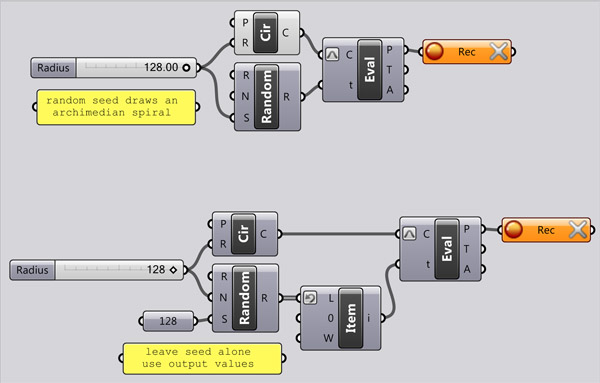Spiral of Random
by Tuğrul Yazar | October 21, 2013 00:04
Grasshopper still surprises me. This definition draws a spiral by using a random component. It is obvious that the seed value of the random component has a relationship with an archimedean or a similar spiral. My intention was to create a definition to put a number of random points inside a circular area, not a rectangular one. While I grow the radius of a circle and get a t parameter evaluation from a random component using the same seed value with the radius, the resulting points started to create this spiral. It was interesting to see the (pseudo)random behavior of the component. Below you see the animation with seeds changing from 0 to 128 and getting the first random output.

Within the same domain, below takes the second random value, and again another beautiful pattern emerges;

However, I solved my real problem by fixing the seed value. Again, the mistake became more significant than the problem. Here is the Grasshopper file if you don’t believe me: [GHX: 0.9.0061][1]

If you want a more “random-like” result, you may use the good old random methods of getting seed values from a physical input such as time. The calculation of milliseconds might be a good choice. Below is a definition that gets the seed value of a random component from the actual milliseconds of any action. This would cause better randomness if you like. Here is the definition file. [GHX: 0.9.0061][2] Don’t worry about the algorithm tickler, its output value is useless, all I want is a manual timer execution so that the random values are always fired by the actual millisecond value exactly when you tickle the Grasshopper.

- [GHX: 0.9.0061]: https://www.designcoding.net/decoder/wp-content/uploads/2013/10/2013_10_20-random.ghx
- [GHX: 0.9.0061]: https://www.designcoding.net/decoder/wp-content/uploads/2013/10/2013_10_20-tickle.ghx
Source URL: https://www.designcoding.net/spiral-of-random/